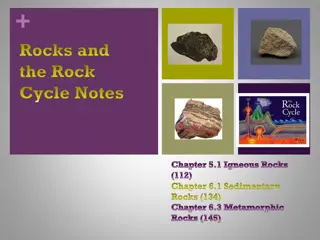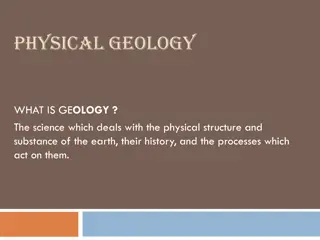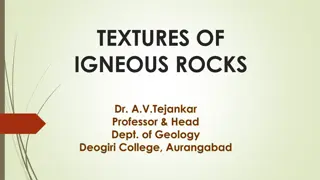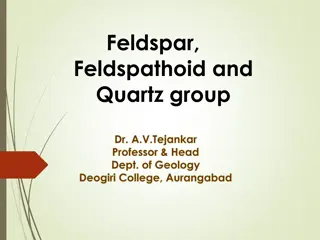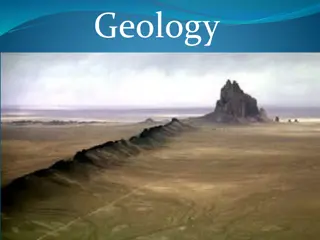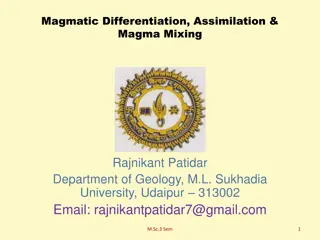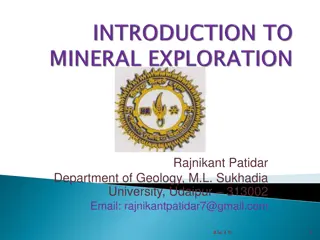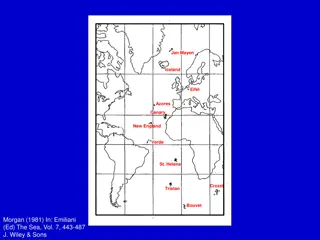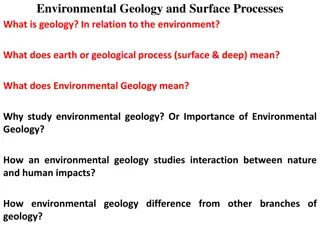Exploring Diverse Igneous Geology in and around the Columbia Hills
Studying the diverse igneous geology in and around the Columbia Hills provides insights into Martian atmosphere, volatile budget, age, source characteristics, cooling history, and more. Researchers have uncovered valuable information by coupling unaltered igneous rocks with meteorites and surface spectroscopy, shedding light on fractionation processes and magma evolution. Key findings offer a deeper understanding of Mars' mantle water budget, magma diversity, and rock crystallization processes.
Download Presentation

Please find below an Image/Link to download the presentation.
The content on the website is provided AS IS for your information and personal use only. It may not be sold, licensed, or shared on other websites without obtaining consent from the author. Download presentation by click this link. If you encounter any issues during the download, it is possible that the publisher has removed the file from their server.
E N D
Presentation Transcript
Diverse Igneous Geology in and around the Columbia Hills for Diverse Science Investigations Hanna Nekvasil1; Steve Ruff2, Donald Lindsley1, Vicky Hamilton3, Nicholas DiFrancesco1, and Francis McCubbin4 1 Stony Brook University 2Arizona State University 3Southwest Research Institute 4Johnson Space Center NOTE ADDED BY JPL WEBMASTER: This content has not been approved or adopted by, NASA, JPL, or the California Institute of Technology. This document is being made available for information purposes only, and any views and opinions expressed herein do not necessarily state or reflect those of NASA, JPL, or the California Institute of Technology.
Martian atmosphere Sulfates and chlorides on the surface VOLATILE BUDGET Bulk volatiles (e.g., OH, Cl, F, S, B) Melt inclusion volatile content Volatile loss [e.g., D, 37Cl; 34S; 66Zn] Timing of loss (mineral zoning) Coatings AGE 176Lu/176Hf; 238U/206Pb; 235U/207Pb, 87Rb/87Sr; 40K/40Ar, 147Sm/143Nd fluids P-T HISTORY Geothermometry Geobarometry Oxygen fugacity Phase equilibria SOURCE CHARACTERISTICS Bulk composition Mineral composition Trace element variability Isotope initial ratios 87Rb/87Sr; 147Sm/143Nd, etc Cooling history Diffusion profiles (trace elements and volatiles in minerals) Geospeedometers Mantle characteristics processing Planetary differentiation Crustal structure Crustal dynamics Mars Exploration Rover Mission, JPL, NASA
Unaltered igneous rock has already proven invaluable Coupling to meteorites to show fractionation processes Using Backstay as an evolved hawaiite linked the experimental phase equilibria of a magma with Backstay composition with melt inclusions in the Chassigny dunite. showed that this meteorite may have been a cognate xenolith brought to the surface during an eruption of residual melt constrained the magmatic water content of the Chassigny parent. Nekvasil et al. (2009)
Coupling to surface spectroscopy Using Humphrey (Adirondack Class) as a relatively primitive basalt from the martian mantle how the martian mantle water budget would produce diverse magmas reaching the surface if fractionating at the base of the martian crust McCubbin et al. (2008) how these lavas would change in composition as the crust thickened McCubbin et al. (2008) how crystallization of these lavas on the surface could produce feldspathic rocks of the type seen at Nili Patera and Noachis Terra. Rogers and Nekvasil 2015
Lending insight into alteration processes from high to low temperature
Gusev Crater/Columbia Hills http://marsnext.jpl.nasa.gov/scieng_geo.cfm
3.65 3.65 Ga Ga Wrinkle Wrinkle- -ridged Plains of Gusev ridged Plains of Gusev ( (Early Hesperian) Early Hesperian) Columbia Hills Greeley et al. (2005)
Columbia Hills are embayed by plains basalt (Adirondack Class; Hamilton and Ruff, 2012), thus are likely at least Late Noachian in age (McCoy et al., 2008) Adirondack Class basalt CTX 2.5 km
Adirondack Class: An ideal sample for tying crater retention age to absolute age CTX 2.5 km
Gusev Crater/Columbia Hills http://marsnext.jpl.nasa.gov/scieng_geo.cfm
Humphrey Adirondack Mazatzal 4. Access to unaltered igneous rock as float Rimming the Tennessee Valley: unaltered to modestly altered, massive, aphanitic, alkaline basalts of the Irvine (tholeiitic basalt) and Backstay classes (trachybasalt) are found as exotics [McSween et al., 2006a; Ruff et al., 2006], Adirondack class basalts (picritic basalt) also present, that are prevalent on the plains [McSween et al., 2004, 2006b]. Backstay Irvine Irvine class basalts also dominate the Inner Basin of the Columbia Hills to the south of Husband Hill [Crumpler et al., 2007]. McCoy et al., 2008 Ming et al 2008
Irvine class basalts also dominate the Inner Basin of the Columbia Hills to the south of Husband Hill, where they are often vesicular to scoriaceous [Crumpler et al., 2007]. Descartes class rocks are breccias with angular clasts that can reach a centimeter in size. The origin of these rocks is uncertain, but aqueous alteration of either a pyroclastic volcanic, impact breccia (McCoy et al. 2008) or impact melt breccia (Arvidson et al. 2008). Algonquin series mafic-ultramafic series, olivine rich, relatively unaltered.(Ming et al. 2008) Assemblee: pyroxene+chromite (mantle xenoliths?) Algonquin/Comanche subclass: olivine+pyroxene (ultramafic? .
AlgonquinClass mafic-ultramafic series, olivine rich, relatively unaltered (Ming et al. 2008) Husband Hill Algonquin Class outcrops, including Comanche, appear to be tephra deposits (Ruff et al., 2014) Home Plate
Algonquin - Miami Morphologic And Thermal Expression Comanche/Algonquin outcrops display distinctive knob and ridge morphology and higher thermal inertia than surrounding terrain HiRISE 250 m Comanche THEMIS colorized night IR over CTX
Morphologic And Thermal Expression Additional examples of Comanche/Algonquin- like terrain in kipukas HiRISE: All scenes 250 m across Columbia Hills Promised Land Interpreted by Ruff et al. (2014) as remnants of formerly more extensive Algonquin-like tephra deposits that mantled the region and were eroded prior to flood basalts at 3.65 Ga (Greeley et al., 2005) Italy feature 3 km THEMIS colorized night IR over CTX
With PIXL, SuperCam, SHERLOC Many diverse samples from mainly igneous signature Martian atmosphere Sulfates and chlorides on the surface VOLATILE BUDGET Distribution of volatiles (Cl, Br, Zn, S) in Coatings/dust Igneous P-T HISTORY Geothermometry Geobarometry Oxygen fugacity Phase equilibria Fluid characteristics FRACTIONATION PROCESSES Mineral composition Residual glass Trace element variability SOURCE CHARACTERISTICS Mineral composition Trace element load Irvine Backstay Assemblee Mantle characteristics processing Planetary differentiation Crustal structure Crustal dynamics Mars Exploration Rover Mission, JPL, NASA
Martian atmosphere Sulfates and chlorides on the surface To increasing alteration signatures With PIXL, SuperCam, SHERLOC Igneous P-T HISTORY Geothermometry Geobarometry Oxygen fugacity Phase equilibria INTERACTION WITH/LOSS OF VOLATILES Distribution of volatiles (Cl, Br, Zn, S) in matrix and or surface Changes in mineral composition Changes in trace element load FRACTIONATION PROCESSES Mineral composition Residual glass Trace element variability Wishstone Everett Peace Vapor deposits? Brines? Magmatic or meteoric water? Crustal structure Crustal dynamics Mars Exploration Rover Mission, JPL, NASA
Diverse Igneous Geology in and around the Columbia Hills for Diverse Science Investigations


